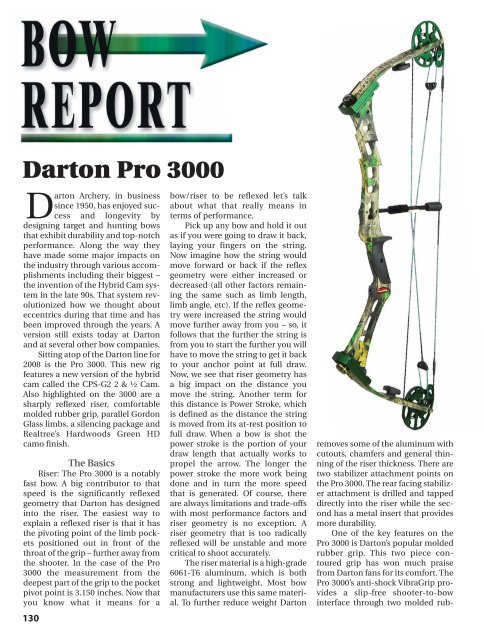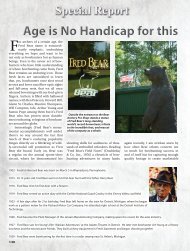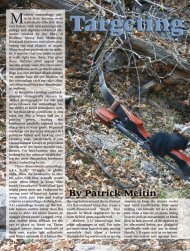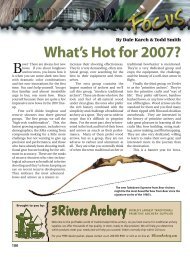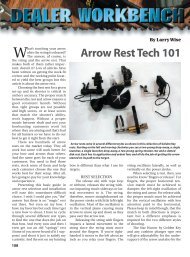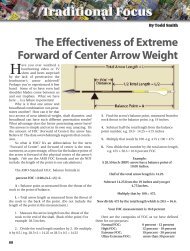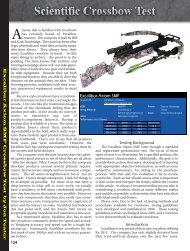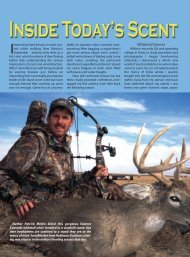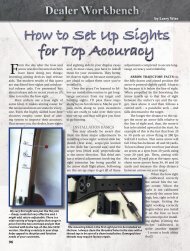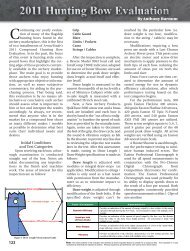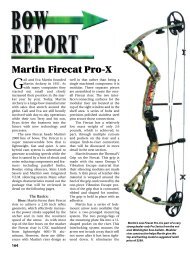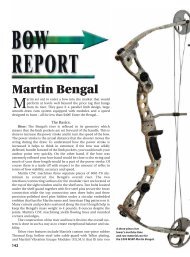Darton Pro 3000 - Arrow Trade Magazine!
Darton Pro 3000 - Arrow Trade Magazine!
Darton Pro 3000 - Arrow Trade Magazine!
You also want an ePaper? Increase the reach of your titles
YUMPU automatically turns print PDFs into web optimized ePapers that Google loves.
<strong>Darton</strong> <strong>Pro</strong> <strong>3000</strong><br />
<strong>Darton</strong> Archery, in business<br />
since 1950, has enjoyed success<br />
and longevity by<br />
designing target and hunting bows<br />
that exhibit durability and top-notch<br />
performance. Along the way they<br />
have made some major impacts on<br />
the industry through various accomplishments<br />
including their biggest –<br />
the invention of the Hybrid Cam system<br />
in the late 90s. That system revolutionized<br />
how we thought about<br />
eccentrics during that time and has<br />
been improved through the years. A<br />
version still exists today at <strong>Darton</strong><br />
and at several other bow companies.<br />
Sitting atop of the <strong>Darton</strong> line for<br />
2008 is the <strong>Pro</strong> <strong>3000</strong>. This new rig<br />
features a new version of the hybrid<br />
cam called the CPS-G2 2 & ½ Cam.<br />
Also highlighted on the <strong>3000</strong> are a<br />
sharply reflexed riser, comfortable<br />
molded rubber grip, parallel Gordon<br />
Glass limbs, a silencing package and<br />
Realtree’s Hardwoods Green HD<br />
camo finish.<br />
The Basics<br />
Riser: The <strong>Pro</strong> <strong>3000</strong> is a notably<br />
fast bow. A big contributor to that<br />
speed is the significantly reflexed<br />
geometry that <strong>Darton</strong> has designed<br />
into the riser. The easiest way to<br />
explain a reflexed riser is that it has<br />
the pivoting point of the limb pockets<br />
positioned out in front of the<br />
throat of the grip – further away from<br />
the shooter. In the case of the <strong>Pro</strong><br />
<strong>3000</strong> the measurement from the<br />
deepest part of the grip to the pocket<br />
pivot point is 3.150 inches. Now that<br />
you know what it means for a<br />
130<br />
bow/riser to be reflexed let’s talk<br />
about what that really means in<br />
terms of performance.<br />
Pick up any bow and hold it out<br />
as if you were going to draw it back,<br />
laying your fingers on the string.<br />
Now imagine how the string would<br />
move forward or back if the reflex<br />
geometry were either increased or<br />
decreased (all other factors remaining<br />
the same such as limb length,<br />
limb angle, etc). If the reflex geometry<br />
were increased the string would<br />
move further away from you – so, it<br />
follows that the further the string is<br />
from you to start the further you will<br />
have to move the string to get it back<br />
to your anchor point at full draw.<br />
Now, we see that riser geometry has<br />
a big impact on the distance you<br />
move the string. Another term for<br />
this distance is Power Stroke, which<br />
is defined as the distance the string<br />
is moved from its at-rest position to<br />
full draw. When a bow is shot the<br />
power stroke is the portion of your<br />
draw length that actually works to<br />
propel the arrow. The longer the<br />
power stroke the more work being<br />
done and in turn the more speed<br />
that is generated. Of course, there<br />
are always limitations and trade-offs<br />
with most performance factors and<br />
riser geometry is no exception. A<br />
riser geometry that is too radically<br />
reflexed will be unstable and more<br />
critical to shoot accurately.<br />
The riser material is a high-grade<br />
6061-T6 aluminum, which is both<br />
strong and lightweight. Most bow<br />
manufacturers use this same material.<br />
To further reduce weight <strong>Darton</strong><br />
removes some of the aluminum with<br />
cutouts, chamfers and general thinning<br />
of the riser thickness. There are<br />
two stabilizer attachment points on<br />
the <strong>Pro</strong> <strong>3000</strong>. The rear facing stabilizer<br />
attachment is drilled and tapped<br />
directly into the riser while the second<br />
has a metal insert that provides<br />
more durability.<br />
One of the key features on the<br />
<strong>Pro</strong> <strong>3000</strong> is <strong>Darton</strong>’s popular molded<br />
rubber grip. This two piece contoured<br />
grip has won much praise<br />
from <strong>Darton</strong> fans for its comfort. The<br />
<strong>Pro</strong> <strong>3000</strong>’s anti-shock VibraGrip provides<br />
a slip-free shooter-to-bow<br />
interface through two molded rub-
er side panels. The lack of rubber<br />
material on the rear-facing portion<br />
of the grip allows the shooter’s hand<br />
to consistently seat into a repeatable<br />
position.<br />
A film dipping process is used to<br />
apply the <strong>Pro</strong> <strong>3000</strong>’s Realtree<br />
Hardwoods Green HD camo pattern<br />
to both limbs and riser. Target colors<br />
are also offered in Black Nickel<br />
Chrome and Illusion Blue Chrome.<br />
Customer Connection: The riser<br />
is the core of the bow. How it is<br />
designed and arranged has much to<br />
do with how the rest of the bow is set<br />
up and the resultant performance.<br />
For the <strong>Pro</strong> <strong>3000</strong> that comes down to<br />
the reflexed geometry impacting<br />
speed.<br />
Two things will most likely come<br />
out of putting the <strong>Pro</strong> <strong>3000</strong> into your<br />
customer’s hands. First will be their<br />
impression of the grip. In my experience<br />
most folks who handle the<br />
<strong>Darton</strong> line like how these bows feel<br />
in their hands – a selling point. The<br />
second discussion you may have<br />
with your customer could center on<br />
the mass weight. It is slightly heavier<br />
than average at 4.6 pounds, however,<br />
I have found that the stability of this<br />
rig, which is undoubtedly and positively<br />
impacted by this fact, far outweighs<br />
(pun intended) any downside.<br />
Limbs/limb pockets: <strong>Darton</strong><br />
relies on industry standard Gordon<br />
Composites for their limb material.<br />
Gordon’s reputation has been<br />
earned and proven thousands of<br />
times over as their materials have<br />
shown up on countless rigs over<br />
many years. Limbs, which are<br />
matched based on deflection values,<br />
are precision machined for repeatable<br />
and consistent performance.<br />
<strong>Darton</strong>’s EFLEX Pre-Loaded Energy<br />
limbs are solid (not split), straight<br />
(not recurve), measure 13 inches in<br />
length and achieve a parallel position<br />
at full draw. When you select a<br />
particular draw weight for your bow<br />
you are actually choosing between<br />
different sets of limbs. Limbs can be<br />
chosen with peak draw weights of<br />
50, 60 or 70 pounds. All peak draw<br />
weights can be adjusted 10 pounds<br />
down.<br />
<strong>Pro</strong> <strong>3000</strong> limb pockets are CNC<br />
machined and are made with the<br />
same aluminum material as is used<br />
for the riser. More importantly is the<br />
precision with which they are<br />
machined and their method of operation.<br />
The precise machining<br />
ensures an accurate and consistent<br />
fit between the riser and pocket. The<br />
pocket’s operation is also key in that<br />
they pivot when the draw weight is<br />
adjusted. The alternative is to hold<br />
the pocket stationary while the limbs<br />
move within the pocket during draw<br />
weight adjustment. A pivoting pocket,<br />
rather than a pivoting limb more<br />
precisely controls the movement<br />
and tolerances at this critical riserto-limb<br />
interface. Limb pockets are<br />
green anodized.<br />
Customer Connection: Pivoting<br />
pockets are more precise and consistent<br />
than the alternative - Another<br />
selling point.<br />
The second big selling point is<br />
the material and construction of the<br />
limbs. Point out the Gordon material<br />
and talk about their reputation for<br />
providing long lasting trouble free<br />
limb materials.<br />
Another obvious selling point is<br />
the position of the limbs at full draw<br />
- parallel. In short, parallel limbs<br />
equal a quieter and reduced shock<br />
shooting experience.<br />
Eccentrics: Where the riser is<br />
the core of the <strong>Pro</strong> <strong>3000</strong>, <strong>Darton</strong>’s<br />
new and patented CPS-G2 2-½ Cam<br />
system, is the heart. Lest anyone forget,<br />
<strong>Darton</strong> was the creator of the<br />
hybrid cam system. Many others<br />
have adopted and made changes to<br />
it but <strong>Darton</strong> was the first. This gives<br />
them the distinct advantage of<br />
native knowledge and experience.<br />
They have been perfecting the technology<br />
for years and the 2008 G2 is<br />
their most advanced to date with<br />
advertised IBO speeds reaching 333<br />
feet per second. An additional<br />
groove on both cams increases the<br />
groove count by ½. This is where<br />
<strong>Darton</strong> came up with the term 2-½<br />
Cam. In the traditional 2-cam style<br />
eccentric system there were certain<br />
issues related to timing and synchronization.<br />
<strong>Darton</strong> designed their new<br />
G2 to eliminate or at least minimize<br />
these issues by tying the <strong>Pro</strong> <strong>3000</strong>’s<br />
cables to a rotating groove on the<br />
cam making it virtually impossible<br />
for them to work independently of<br />
one another. That feature allows the<br />
cams to be out of optimum “tune”<br />
and still retain shootability, meaning<br />
nock travel will remain constant and<br />
the “double bump” normally felt by<br />
About The Author<br />
Jon E. Silks has a degree in Quality Engineering and works in the area of nondestructive<br />
testing technology. His entire career has centered around the testing<br />
and evaluation of products. Now 38, he’s been bowhunting since age 12. Silks<br />
started writing for magazines and websites seven years ago and since then has<br />
done more than 400 product reviews. Manufacturers who appreciate his thoroughness<br />
and frankness have often asked him to review products that are still in<br />
the development<br />
stage. Silk’s work has<br />
appeared on the web<br />
on Bowhunting.net<br />
and Bowsite.com and<br />
has been published in<br />
Petersen’s Bowhunting,<br />
Bowhunter, <strong>Arrow</strong><br />
Adventure, and Whitetail<br />
Fanatic, along with<br />
<strong>Arrow</strong><strong>Trade</strong>. Jon and<br />
Jennifer Silks have six<br />
children and live in<br />
Pennsylvania. Silks can<br />
be reached at jon@silksoutdoors.com.<br />
131
the shooter when cam-mounted<br />
draw stops hit at different times will<br />
be eliminated.<br />
G2 cams also include <strong>Darton</strong>’s<br />
patented Tuning Mark System that<br />
consists of two engraved lines per<br />
cam within which the cables should<br />
be positioned while the bow is at rest.<br />
If the cables are outside the lines they<br />
either need to be lengthened or<br />
shortened to bring them back into<br />
position and achieve top performance.<br />
Want to make sure the <strong>Pro</strong><br />
<strong>3000</strong> is performing at its absolute<br />
best? Simply make sure that both<br />
cables are within the tuning marks of<br />
each cam and that the axle-to-axle<br />
length measures 34.375 inches.<br />
Both cams ride on sealed ball<br />
bearings for less friction and more<br />
performance. The G2 is modular<br />
offering draw length options<br />
between 25 and 30 inches in ½-inch<br />
increments. System letoff is advertised<br />
at 80 percent effective.<br />
Eccentrics are green anodized.<br />
Customer Connection: Imitation,<br />
as the saying goes, is the highest form<br />
of flattery. You know you are on to<br />
something good when others jump<br />
in to use what you have created. That<br />
is exactly what happened when<br />
<strong>Darton</strong> came out with the very first<br />
hybrid cam system. The concept and<br />
performance has become a cornerstone<br />
in the industry – not a bad selling<br />
point to start out with.<br />
Simplicity. Many of your customers<br />
do not have the means to<br />
determine if their bow is operating as<br />
it should be. <strong>Darton</strong> has made that<br />
possible for them by offering their<br />
straightforward tuning mark system.<br />
As stated above - Simply make sure<br />
that both cables are within the tuning<br />
marks of each cam and that the axleto-axle<br />
length measures 34.375 inches.<br />
Doesn’t get much easier.<br />
Silencing/Shock reducing features:<br />
What is better than a fast bow?<br />
A fast bow that also demonstrates<br />
minimal shock, vibration and noise<br />
levels! With that in mind <strong>Darton</strong><br />
makes use of several technologies<br />
and features on the <strong>Pro</strong> <strong>3000</strong>.<br />
<strong>Pro</strong>bably the biggest contributor is<br />
the parallel position of the limbs at<br />
full draw. When the bow is shot these<br />
132<br />
<strong>Darton</strong> bow designer Rex Darlington deserves credit for introducing hybrid cam systems<br />
to the archery market. This CPS-G2 is a modular cam system allowing 1/2 draw<br />
length changes. The upper and lower cams are slaved together so your draw length will<br />
increase if a string stretches, but upper and lower cams will still rotate in time.<br />
limbs travel in equal and opposite<br />
directions eliminating much of the<br />
shock and vibration-causing energy<br />
normally produced by upright limb<br />
configurations. The <strong>Pro</strong> <strong>3000</strong> is also<br />
home to Sims Limb Savers and<br />
<strong>Darton</strong>’s own cable guard mounted<br />
string suppression system.<br />
Customer Connection: I hesitate<br />
to even enter anything here. Find for<br />
me an archer that actually prefers a<br />
louder bow with a heavy dose of<br />
hand shock… Exactly – they don’t<br />
exist, so this category is a no-brainer.<br />
Testing<br />
Tests were conducted using the<br />
following equipment:<br />
Spot-Hogg Hooter Shooter portable<br />
shooting machine<br />
Easton <strong>Pro</strong>fessional Chronograph<br />
with an infrared lighting system<br />
Easton BowForce Mapper Handheld<br />
unit<br />
Oehler M35 Chronograph<br />
Easton Digital Bow Scale<br />
Apple Super <strong>Pro</strong> Bow Press<br />
Modified Apple Bow Drawing<br />
Machine<br />
NAP QuikTune <strong>3000</strong> <strong>Arrow</strong> Rest<br />
TRU Ball Chappy Boss release<br />
Set up: A 30 inch draw length and<br />
70 pound draw weight has become<br />
the industry-accepted specs for IBO<br />
ratings. If not already within the tolerances<br />
of ASTM F 1544-04 the draw<br />
length will be adjusted to 30 inches,<br />
+/- .25 inch, and the draw weight will<br />
be set to 70 pounds, +/- 1 lb (the +/-<br />
1 lb requirement is also an ASTM F<br />
1544 -04 requirement). Speeds will be<br />
measured using a correctly spined<br />
350-grain arrow. This weight comes<br />
from the IBO rule, which states that,<br />
“<strong>Arrow</strong>s must weigh at least 5 grains<br />
per pound of the bow’s maximum<br />
shooting weight…” As stated earlier<br />
<strong>Arrow</strong> <strong>Trade</strong> bows will be tested at 70<br />
pounds so: using the I.B.O. rule we<br />
would multiply 5 grains x 70 pounds<br />
= 350 grains. To summarize our<br />
<strong>Arrow</strong><strong>Trade</strong> Standard:<br />
Bow weight: 70 pounds +/- 1 pound<br />
Draw Length will be set to 30 inch ATA<br />
(defined by ASTM F 1544-04)<br />
<strong>Arrow</strong>s will be selected according to<br />
the formula set out in the I.B.O.<br />
rules for minimum grains per<br />
pound (350 grains)<br />
All arrow velocity ratings must be<br />
measured using a shooting<br />
machine with mechanical release<br />
(We will use the definition of a<br />
shooting machine found in ASTM F
Load - increasing ---><br />
1544-04)<br />
A minimum of five shots must be<br />
chronographed using an arrow as<br />
defined above. The five shots will<br />
then be averaged to obtain the final<br />
reading. All velocity values for a<br />
given arrow must fall within a<br />
range of 2 ft/sec (Taken from ASTM<br />
F 1544-04).<br />
An appropriate chronograph with a<br />
minimum of two gates set no more<br />
than 48 inches apart will be used.<br />
The initial gate will be set at 36 inch<br />
from the front of the bow’s handle.<br />
A single brass nock and<br />
QuikTune 300 <strong>Arrow</strong> Rest were<br />
attached to the bow – nothing more.<br />
With the exception of these two<br />
items every bow is tested as it would<br />
be shipped to the dealer or customer.<br />
In other words, if it has string<br />
silencers or other components preinstalled<br />
it is tested with them<br />
installed. While the ‘official’ velocity<br />
rating for our calculations will be<br />
taken with an arrow as defined<br />
above, we will also use two other test<br />
arrows as reference points. This will<br />
be done to bring a bracketed picture<br />
of the bow’s speed performance to<br />
the reader. Test arrows include a<br />
lightweight 350-grain CAE carbon<br />
arrow, a mid-weight 420-grain Radial<br />
Peak Force -= 70 pounds<br />
Draw Length - increasing ---><br />
X Weave arrow and a relatively heavy<br />
540-grain Easton XX78 Super Slam<br />
arrow. Before recording speeds with<br />
these arrows the bow was first paper<br />
tuned with each one. Most every<br />
bowhunter/archer will be able to<br />
extrapolate their approximate arrow<br />
speed in relation to similar set-up<br />
parameters and results presented<br />
from the three test arrows.<br />
Speed/Velocity Test: Speed was<br />
measured with the two chronographs<br />
listed above – Easton’s model<br />
as the primary and the Oehler as a<br />
backup/verification unit. Following<br />
are the resulting speed ratings for<br />
each in feet per second rounded to<br />
the nearest whole number:<br />
540-grain arrow<br />
274.8<br />
274.8<br />
274.8<br />
274.6<br />
274.2<br />
Average: 275 fps<br />
420-grain arrow<br />
305.4<br />
305<br />
304.8<br />
305.2<br />
305<br />
Average: 305 fps<br />
Draw Length = 30"<br />
350-grain arrow<br />
329.2<br />
329.4<br />
329.5<br />
329.6<br />
329.2<br />
329.4<br />
Rounded Average: 329 fps<br />
Circle 197 on Response Card<br />
133
Potential customers will generally<br />
make their bow purchase choice<br />
based on several factors including<br />
the cost, speed, shot noise,<br />
shock/vibration level, grip and the<br />
draw cycle.<br />
In our testing for <strong>Arrow</strong><strong>Trade</strong><br />
<strong>Magazine</strong> we try to give you a feel for<br />
how a bow performs in the “subjective”<br />
areas mentioned above. You can<br />
then focus on the bow’s notable subjective<br />
points when interacting with<br />
your customer. The term “subjective”<br />
can basically be translated into<br />
“opinion”. I will be giving my opinion<br />
of this bow’s performance in the following<br />
subjective categories:<br />
Shot noise<br />
Grip comfort and function<br />
Draw cycle “feel”<br />
Shock and vibration levels<br />
Shot noise, or better defined as<br />
the lack of shot noise, is remarkable<br />
on the <strong>Pro</strong> <strong>3000</strong>. It is easily one of the<br />
quietest rigs I have tested so far in<br />
2008. There isn’t much else to say<br />
when a rig is this quiet. You just have<br />
to shoot it to understand. This is one<br />
of those benefits that come partially<br />
from the 4.6-pound mass weight.<br />
Talk to a <strong>Darton</strong> fan and ask<br />
them what are the three things that<br />
they like most about their rig and<br />
almost without fail one of those will<br />
be the grip. The <strong>Pro</strong> <strong>3000</strong>’s anti-shock<br />
VibraGrip is indeed comfortable and<br />
will surely provide a measure of<br />
warmth over all metal or hard plastic<br />
grips on windy, cold November days.<br />
Now, if the molded grip was a onepiece<br />
design there may be issues with<br />
torque, however, there is sufficient<br />
134 Circle 220 on Response Card<br />
smooth metal surface<br />
exposed to allow<br />
the shooter’s hand to<br />
consistently find its<br />
position each shot. I<br />
found that if I<br />
opened my hand up<br />
while drawing the<br />
bow that I had no<br />
issues with torque.<br />
Considering the<br />
speed generated out<br />
of this cam system I<br />
was happy with the<br />
draw cycle. It is<br />
aggressive but not<br />
too harsh and has no<br />
sharp changes that I<br />
could feel. A smooth<br />
draw cycle has been<br />
a defining quality of the hybrid cam<br />
system since its inception. Check out<br />
the draw force curve to see how the<br />
transitions to peak and back to holding<br />
weight are rounded off.<br />
Shock and vibration levels often<br />
go hand-in-hand with noise levels<br />
and that holds true with the <strong>Pro</strong> <strong>3000</strong><br />
to a degree. Vibration levels are<br />
almost non-existent, however, there<br />
is a noticeable bump in the handle<br />
when the bow is shot. It isn’t bone<br />
jarring by any means, just not as<br />
impressive as the lack of noise at the<br />
shot.<br />
<strong>Darton</strong>’s <strong>Pro</strong> <strong>3000</strong> is a top-end rig<br />
by every count. It flat out performs<br />
well in all categories that bowhunters<br />
are concerned with. The company<br />
has proven they are in the game to<br />
stay and they bring a wealth of<br />
knowledge and experience to the<br />
table. The latest version of their<br />
patented hybrid cam system is a win-<br />
<strong>Darton</strong> <strong>Pro</strong> <strong>3000</strong><br />
Draw weights: 50, 60, and 70 pound peak<br />
Draw Lengths: 25 to 30 inches in .5 increments<br />
Axle-to-axle length: 34.375 inches<br />
Brace Height: 6.25 inches<br />
Mass Weight: 4.6 pounds<br />
Let-off option: 80 percent effective<br />
Eccentrics: CPS-G2 2 ½ Cam<br />
Strings and cables: BCY 452<br />
Tested speed: 329 fps tested<br />
Available hunting finish: RT Hardwoods Green HD<br />
Grip: Two-piece molded rubber<br />
Riser: CNC machined aluminum - reflex<br />
Limb pocket: CNC machined aluminum - pivoting<br />
Limbs: 13 inch Gordon Glass<br />
Cable Guard: Straight Graphite<br />
Warranty: Limited Lifetime<br />
MSRP: $845.00<br />
ner as well, generating terrific IBO<br />
speeds with a smooth draw.<br />
Test Bow Technical Info<br />
(350-grain arrow/ 70 pound peak<br />
draw weight/30 inch draw length)<br />
Measured Speed: 329 fps<br />
Kinetic Energy: 84.14 footpounds<br />
(This is the energy that actually<br />
goes into propelling the arrow.<br />
Basically it is the energy that is left<br />
over from the stored energy after all<br />
of the bow system friction is accounted<br />
for.)<br />
Stored Energy: 107.02 footpounds<br />
(When you draw the bow you<br />
supply power/energy into the limbs.<br />
The amount of energy that the limbs<br />
can hold is known as the stored energy.)<br />
Efficiency Rating: 78.62 percent<br />
(This is the amount of the stored<br />
energy (in percent) that can be successfully<br />
transferred into propelling<br />
the arrow upon release. The bow<br />
design, including limbs, limb pockets,<br />
cam systems, and axle types play<br />
into the bow’s efficiency.<br />
SE/PF Ratio: 1.53 This is the<br />
ratio of stored energy to peak force.<br />
In other words what return are you<br />
getting for the power you supply.
<strong>Darton</strong> Ranger III<br />
<strong>Darton</strong>, a solid performer in<br />
every respect, has been in<br />
the business of producing<br />
archery equipment for an incredible<br />
58 years. Few other bow companies<br />
even get close to that measure of<br />
experience. Their introductory statement<br />
in the 2008 catalog contains a<br />
particular declaration that caught<br />
my attention, “… we believe that<br />
perfection cannot exist in an imperfect<br />
world. For <strong>Darton</strong>, perfection is<br />
the pursuit of excellence…” That is<br />
an incredibly insightful remark – I<br />
like it! No doubt that is one of the<br />
keys to their longevity.<br />
<strong>Darton</strong> offers their Action Series<br />
containing three Ranger bow models<br />
to youngsters looking to get into the<br />
sport. A noteworthy benefit found in<br />
the Ranger line of bows is the capability<br />
to grow significantly with<br />
bowhunter-to-be. The Ranger III will<br />
be covered here. This rig adjusts 30<br />
pounds in draw weight, from 17 to 28<br />
inches in draw length and is fully<br />
decked out in Realtree’s Hardwoods<br />
Green HD camo.<br />
Riser<br />
The Ranger III has a distinctive<br />
riser in that it is notably slender<br />
throughout and rounded off at every<br />
corner. Actually, it is more than just<br />
rounded corners because there really<br />
are no corners. Rather the radius<br />
continues from one side of the riser<br />
to the other. This unique geometry is<br />
made possible by the permanent<br />
mold manufacturing process used to<br />
create the R3 riser. The permanent<br />
mold process is a lower cost method<br />
used to make large lots of high<br />
strength parts. Permanent molding<br />
is mainly used for nonferrous metals<br />
and alloys, in this case 356 aluminum,<br />
and usually employs two<br />
iron or steel halves that have<br />
bowls/spouts on the sides. The<br />
molten metal is poured into the<br />
bowls at which time gravity takes<br />
over distributing the metal throughout<br />
the mold cavity. Overall the riser<br />
measures approximately 18 inches<br />
in length and has a total reflex geometry<br />
of 1.25 inches. The short length<br />
and narrow build of the riser play a<br />
big part in keeping the Ranger III’s<br />
mass weight to only 2.9 pounds.<br />
<strong>Darton</strong> sticks to what has worked for<br />
them on other models by utilizing a<br />
comfortable 2-piece rubber grip. The<br />
grip is also textured for additional<br />
comfort. Other riser stats include a<br />
straight graphite cable guard and<br />
standard mounting holes for rest,<br />
sight and stabilizer. <strong>Darton</strong> hydrographically<br />
decorates their Ranger<br />
III riser with Realtree’s Hardwoods<br />
Green HD camo pattern. For a<br />
detailed explanation of the hydrographic<br />
decorating process see the<br />
story on Outdoor Colors also found<br />
in this issue.<br />
So, what does all this mean to<br />
Mom, Dad and/or the shooter?<br />
This bow is super light at only 2.9<br />
pounds and offers comfort with its<br />
soft rubber grip. These qualities are<br />
especially important for the young<br />
archer.<br />
A big reason for the attractive<br />
$266.63 manufacturer’s suggested<br />
retail price is the permanent mold<br />
riser. It would be very difficult if not<br />
impossible to manufacture an<br />
attractive machined aluminum riser<br />
for sale in this price range.<br />
Realtree’s Hardwoods Green HD<br />
camo pattern looks great on the<br />
molded riser.<br />
135
Limbs/Limb Pockets<br />
Another contributor to the lower<br />
cost of the Ranger III is the molded<br />
black Nylon limb pocket. A molded<br />
Nylon pocket is significantly more<br />
economical to manufacture than a<br />
cast or machined aluminum pocket.<br />
One could argue the loss of precision<br />
and accuracy in this pocket verses a<br />
machined aluminum pocket, however,<br />
I would return the argument<br />
with one of my own. For archers who<br />
would be using this bow it is doubtful<br />
that they would suffer any setbacks<br />
from the negligible differences<br />
attributed to limb pocket material or<br />
manufacturing processes. The<br />
Ranger III’s pockets are a traditional<br />
closed-end, non-pivoting style.<br />
<strong>Darton</strong> depends on the materials<br />
from industry-standard Gordon<br />
Composites for the Ranger III’s<br />
limbs. As mentioned in many of my<br />
previous bow reviews Gordon’s reputation<br />
has been earned and proven<br />
thousands of times over as their<br />
materials have proven themselves<br />
on countless rigs over many years.<br />
The 13.5 inch limbs are machined<br />
into their final form before going<br />
through a dipping process to apply<br />
the Realtree Hardwoods Green HD<br />
camo pattern. Limbs offer an incredible<br />
draw weight range from 15 to 45<br />
pounds.<br />
So, what does all this mean to<br />
Mom, Dad and/or the shooter?<br />
Again, the cost of the Ranger III<br />
comes up – this time in how the limb<br />
pockets are made. The pockets are<br />
rugged and sufficient for beginning<br />
archers and the overall cost of the<br />
bow is easy to take.<br />
Gordon Glass limbs on this<br />
beginner’s youth bow – strength and<br />
performance where it is needed. A<br />
great feature.<br />
A draw weight range spanning<br />
30 pounds on one rig is a huge plus<br />
in a youth bow!<br />
Eccentrics<br />
As we discuss youth bows one of<br />
the major goals for any manufacturer<br />
is to maximize the variability to<br />
keep up with growing kids. Draw<br />
weights and draw lengths seem to<br />
136<br />
Load in pounds Increasing ><br />
be a constantly moving target for<br />
kids. The Ranger III’s eccentric system<br />
actually has features that<br />
impact both. Most cam configurations<br />
only affect the draw length,<br />
however, this system has a power<br />
cable adjustment post that swings<br />
the draw weight range a full 10<br />
pounds. Draw lengths, which are<br />
modular and can be adjusted without<br />
the use of a bow press, range<br />
from 17 to 28 inches. That is super<br />
adjustability on 9 modules.<br />
Eccentric system letoff is rated at 75<br />
percent effective and 70 percent as<br />
measured by Archery <strong>Trade</strong><br />
Association (ATA) standards (formerly<br />
AMO). Both cam and idler<br />
wheel ride on bushings.<br />
So, what does all this mean to<br />
Mom, Dad and/or the shooter?<br />
This cam system offers 17 to 28<br />
inches of draw length adjustability –<br />
a true benefit for growing archers<br />
and shrinking wallets.<br />
A cam post that swings the draw<br />
weight range a full 10 pounds on top<br />
of the normal adjustability of the<br />
limb bolt - Another boost to adjustability!<br />
Draw in inches Increasing ><br />
Testing:<br />
Tests were conducted using the<br />
following equipment:<br />
Spot-Hogg Hooter Shooter portable<br />
shooting machine<br />
Easton <strong>Pro</strong>fessional Chronograph<br />
with an infrared lighting system<br />
Oehler M35 Chronograph<br />
Easton Digital Bow Scale<br />
Modified Apple Bow Drawing<br />
Machine<br />
NAP QuikTune <strong>3000</strong> <strong>Arrow</strong> Rest<br />
Tru Ball Chappy Boss release<br />
The Ranger III was set to 23 inch<br />
draw length and equipped with a<br />
single brass nock and N.A.P.<br />
QuikTune <strong>3000</strong> arrow rest – nothing<br />
else was added to the bow. With the<br />
exception of these two items, every<br />
bow is tested unchanged - as it<br />
would be shipped to the dealer or<br />
customer.<br />
Speed was measured on the<br />
Ranger III with the chronographs<br />
listed above. Generally the testing is<br />
performed at three different draw<br />
weights (40, 45 and 50 pounds), however,<br />
the test bow is only rated for a<br />
maximum of 45 pounds and was<br />
only capable of 41 pounds. So, all<br />
testing will be at 40 pounds. Two<br />
arrows, one 260 grains and the other
328 grains were used.<br />
Following are the resulting speed<br />
ratings (rounded to the nearest<br />
whole number) for each in feet per<br />
second:<br />
138<br />
260-grain arrow: 40 pound draw<br />
194<br />
194<br />
194<br />
195.4<br />
194<br />
195.3<br />
194<br />
195.4<br />
Average: 195 fps<br />
328-grain arrow: 40 pound draw<br />
178<br />
179<br />
179<br />
179.7<br />
178<br />
179.8<br />
178<br />
179.5<br />
Average: 179 fps<br />
The Ranger III’s<br />
draw cycle is as it<br />
should be on a youth<br />
bow – well rounded,<br />
which translates to<br />
smooth. You can see<br />
the seamless transitions<br />
to peak and<br />
then down to holding<br />
weight on the<br />
attached force draw<br />
curve.<br />
When shot the<br />
Ranger III acted in a<br />
manner that I would<br />
expect from a bow<br />
with upright limbs<br />
(not parallel at full<br />
draw) in that it<br />
reported a small<br />
“jump” in the handle and a moderate<br />
level of vibration. The noise followed<br />
suit and would be considered<br />
average by most. What I did notice<br />
is that the noise sounded to be<br />
mostly generated by the string<br />
vibrating. I tied rubber bands onto<br />
the string where regular string<br />
<strong>Darton</strong> Ranger III<br />
Draw weights: 15 through 45 pounds<br />
Draw Lengths: 17 to 28 inches achievable through<br />
module options<br />
Axle-to-axle length: 32 inches<br />
Brace Height: 6.875 inches<br />
Mass Weight: 2.9 pounds<br />
Let-off option: 70 percent ATA, 75 percent Effective<br />
Eccentrics: <strong>Darton</strong>’s Single Hybrid Cam<br />
Advertised IBO speed: N/A<br />
Available hunting finish: Realtree<br />
Hardwoods Green HD<br />
Grip: Two-piece molded rubber<br />
Riser: Permanent Mold 356 Aluminum<br />
Limbs: 13.5 inch Gordon Glass<br />
Cable Guard: Graphite cable rod - straight<br />
Warranty: Limited Lifetime<br />
MSRP: $266.63<br />
silencers would be used and the<br />
results were significant. The ranger<br />
III was as silent as they come with<br />
the rubber bands tied on and they<br />
had the added benefit of reducing<br />
the vibration felt in the handle. To<br />
see if I could get even better overall<br />
results I attached a quality stabilizer.<br />
The jump in the handle was all<br />
but eliminated, the noise was cut<br />
even further and the vibration could<br />
not be felt any more. The moral of<br />
the story is that with a stabilizer and<br />
a set of simple string silencers you<br />
get significantly improved performance.<br />
The Ranger III is super maneuverable<br />
with its light mass weight<br />
and short 31.75 inch axle-to-axle<br />
length (as measured on the test<br />
bow). The narrow rubber sided handle<br />
proved to feel as comfortable as it<br />
looks. My son Michael shot the<br />
Ranger III for about an hour and<br />
pointed out his favorite as the grip.<br />
He was also impressed with the big<br />
differences that were afforded by the<br />
stabilizer and rubber band string<br />
silencers.<br />
When considering the <strong>Darton</strong><br />
Ranger III the price cannot be overlooked.<br />
It is one of the lowest cost<br />
quality youth bows available. A<br />
young archer just getting started in<br />
the sport would be well served by the<br />
Ranger III.<br />
Circle 231 on Response Card for Parker Crossbows


